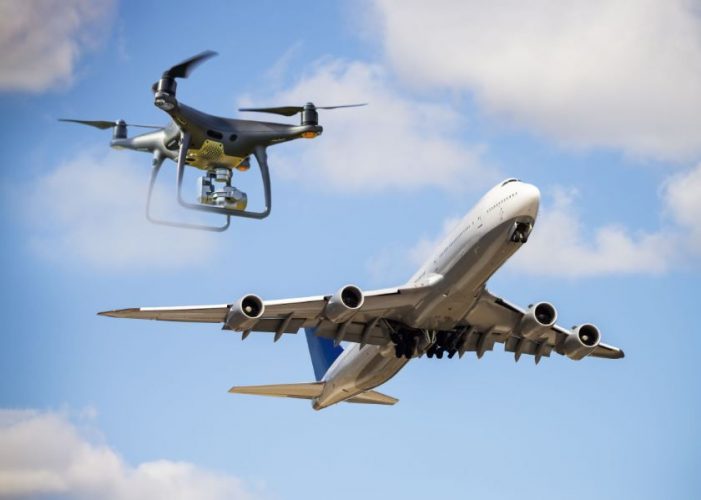A new report from the UK’s Department for Transport’s Connected Places Catapult (CPC), NATS, Altitude Angel, ANRA Technologies, Cranfield University, the Satellite Applications Catapult and Thales UK has been published to outline the UK’s strategy for developing a national UTM system.
The report – Connected Places Catapult: Towards a UTM System for the UK Preparing the UK for the Commercial Drone Industry – includes the architecture for an open access UTM system and scenarios for important areas such as managing permissions to fly drones in restricted airspace and multiple drone operations in in uncontrolled airspace.
According to the report:
“The key underlying principle of the proposed UTM system is its open nature – that is, open to multiple businesses and stakeholders, between whom data can be exchanged, to foster an innovative ecosystem that encourages businesses to deliver innovative services which safely facilitates the commercial and societal exploitation of drone technology. Open-Access UTM is strategically aligned with the Government’s ambition to capitalise on the opportunities around Open Standards that allow for software to inter-operate through open protocols and the adoption of automated data exchange services based on data and digital strategies set out in the Government Transformation Strategy 2017-20203 and the UK Digital Strategy.”
The report provides a clear delineation between UTM service providers and ATM service providers (see box).
| UTM Service Provider UTM Service Providers (UTMSPs) enable UAS operators to safely and efficiently integrate unmanned vehicles into the national airspace. This responsibility/capability is made up through the provision of several services that are listed below:
A. Provide UAS operators with an ability to plan missions considering relevant airspace and aeronautical information. B. Provide UAS operators with an ability plan missions such that flights are not scheduled to conflict with other manned or unmanned flights. C. Communicate relevant information to other UTM and ATM service providers as necessary (including ATM service providers) to enable the service providers and operators to strategically de-conflict, and potentially enact operating risk-mitigation procedures in-flight (i.e. tactical deconfliction). D. Communicate (dynamic) operating restrictions to the operator as required. E. Validate operator information and details (e.g. operating license, insurance, registration information). F. Log operator flight data and archive operations data for analytics, regulatory and operator accountability purposes. Due to the anticipated competitive nature of the UTM service market, service providers will also provide additional services on-top of the aforementioned capabilities to satisfy commercial needs. ATM Service Provider (ATMSP) ATM is required to interface with UTM service providers to assure safety – particularly within the vicinity of airports, as well as throughout controlled airspace. ATM services are considered separate though complimentary to the services provided by UTM service providers. Key capabilities and responsibilities to be maintained by ATMSPs are: A. Monitor conventional manned air traffic. B. Communicate air traffic information to UTM stakeholders as and when necessary (e.g. during emergencies). C. Communicate received unmanned air traffic information to relevant ATM stakeholders as and when necessary. D. Provide permissions to UAS operations when operating within flight restriction zones (FRZ). |
According to a press release:
“There is a huge global opportunity for countries who can successfully accommodate commercial drone operations which can fly “beyond line of sight” of the user alongside other aircraft. As drone technology develops in areas such as automation, and operators become more numerous and sophisticated, new opportunities are emerging in areas such as infrastructure inspection, drone deliveries, agriculture and even personal transport. It is thought the sector could be worth UK127 billion globally.…Preparation has already begun on the next phase of the project. The CPC, along with Altitude Angel ANRA Technologies, GE Aviation and AiRXOS, NATS, Snowflake Software Systems, and Thales will run a series of technical workshops in order to mature the development of the Open-Access UTM framework to enable demonstrations of the future operational use of UTM.“
Mark Westwood, Chief Technology Officer, Connected Places Catapult explained: “As the technology matures, twin pressures of increasingly widespread drone usage independent of a nationally agreed framework, and a strong desire within the industry to investigate the art of the possible, are driving an urgent need for a coordinated approach across stakeholders in government, businesses and regulators. We need to make sure the UK is ready to accommodate this quickly emerging industry and UTM is recognised as a vital component to facilitate the safe and efficient integration of unmanned vehicles into the airspace. We’re hoping actors from across multiple sectors will engage with our research and future aspects of the project to get the job done so the UK drone industry can flourish.”
For more information
Download the full report here.




